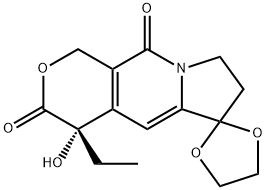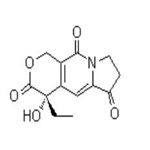Chemical Properties
Light yellow solid.
Uses
(4S)-4-Ethyl-7,8-dihydro-4-hydroxy-1H-pyrano[3,4-f]indolizine-3,6,10(4H)-trione is a key intermediate in the synthesis of Irinotecan (I767500) and Camptothecin (C175150) analogs.
Preparation
Synthesis of (S)-4-Ethyl-4-hydroxy-7,8-dihydro-1h-pyrano[3,4-f]indolizine-3,6,10(4h)-trione: Compound (Formula 4) 4.3 g (100 mmol), 200 ml of dichloromethane, 200 ml of 2M sulfuric acid, stirred at room temperature for 2 h, separated the organic layer, washed with saturated brine, dried, recovered dichloromethane to dryness, and recrystallized from isopropanol to obtain S-tricyclic lactone (Formula 1) 1.5 g, mp 172-174°C, [α]D15+115.6° (C=0.5, chloroform), yield 57%.
![Synthesis of (S)-4-Ethyl-4-hydroxy-7,8-dihydro-1h-pyrano[3,4-f]indolizine-3,6,10(4h)-trione](/NewsImg/2022-07-14/6379343161441863966536659.jpg)
Application
(S)-4-Ethyl-4-hydroxy-7,8-dihydro-1h-pyrano[3,4-f]indolizine-3,6,10(4h)-trione is the key intermediate for the synthesis of a series of (20S)-camptothecin analogues. Since its isolation from the Chinese plant Camptothecaacuminata by Wall et al. In 1966, (20S)-camptothecin, a pent acyclic natural alkaloid, has re-emerged as one of the most important lead compounds for the discovery of new and selective anticancer drugs because of the disclosure of its unique mechanism of action as a selective inhibitor DNA topoisomerase Ⅰ, a process causing irreversible DNA damage and subsequent cell death. Three camptothecin derivatives with high antitumor activity, topotecan, belotecan, and irinotecan, have been launched as anticancer drugs in clinical practice, and many other analogues are at various stages of clinical development.
Clinical claims and research
Camptothecin is a pentacyclic alkaloid extracted from Camptotheca by Wall et al. in the early 1960s. As an anticancer chemical, the compound has quickly attracted people's attention due to its strong inhibitory activity against leukemia and various other malignant tumors in animal experiments. In the total synthesis of camptothecin, The total synthesis of (S)-4-Ethyl-4-hydroxy-7,8-dihydro-1h-pyrano[3,4-f]indolizine-3,6,10(4h)-trione is research focus.
![(S)-4-Ethyl-4-hydroxy-7,8-dihydro-1h-pyrano[3,4-f]indolizine-3,6,10(4h)-trione Structure](https://www.chemicalbook.com/CAS/GIF/110351-94-5.gif)

![Synthesis of (S)-4-Ethyl-4-hydroxy-7,8-dihydro-1h-pyrano[3,4-f]indolizine-3,6,10(4h)-trione](/NewsImg/2022-07-14/6379343161441863966536659.jpg)



